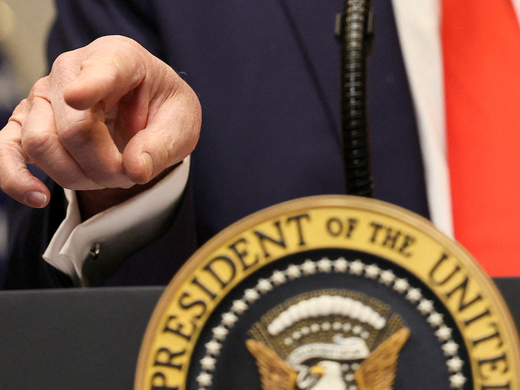In the third decade of the twenty-first century, democracies face a new adversary — technology. Technology was once seen as a force for good, which could bridge the gap between the state and restless streets. Today, owned and controlled by large enterprises and extra-territorial governments, that very technology sometimes undermines the foundations of democracy, where it functions as a public sphere and a vibrant information exchange.
Much of the world has blearily woken up to big tech’s ambitions, expansion and unaccountable power to shape the human condition. A few companies, dotted on America’s West Coast (henceforth referred to as big tech), now possess the ability to harness the digital gold rush — along with the equally overwhelming influence on discourse in democratic societies. In parallel, a rising China, with its rapid successes in building a vibrant technology ecosystem, has unleashed plans to dominate innovation, high technology and the global perceptions ecosystem (henceforth referred to as red tech).
Technology from the West Coast of the United States and technology that seeks to serve the Chinese Communist Party (CCP) have both chosen to pursue their defined objectives with little thought for constitutional systems and laws in third countries. As such, much of the democratic world is at risk of being caught in the vice-like grip of big tech and red tech. It is, therefore, time for democratic societies to discover and examine means to secure an open and free global technological ecosystem that serves all shades of democracy.
Why the Battle for Tech Matters
The threat that big tech poses to democracy is multifaceted. First, major social media platforms — Twitter, Facebook, Google and others — curate, promote and curtail information received by and, indeed, even the opinions of citizens in democratic societies. This power over speech and expression, and therefore over our politics and polity, is unrivalled in history (Baer and Chin 2021). While US steel, big oil and big tobacco were brought to heel by domestic regulations and national governments, the transnational reach of big tech has made it much harder to circumscribe (Lago 2021).
Operating outside rules and regulations prescribed by sovereign constitutions, social media platforms now exercise a worrying level of influence without accountability. Big tech has deplatformed controversial political figures such as Donald Trump (Byers 2021); censored content, a decision that internal ombudsmen disagree with (Eidelman and Ruane 2021); and has encouraged an engagement-based content ranking system that has allowed everything from disinformation about coronavirus disease 2019 (COVID-19) to hate speech to spread (Harris 2021). Platforms are free to decide whether they function as private hosting platforms or providers of a vital public utility; they cannot be both. Yet, they pick and choose between the two functions as it suits them.
National governments have not been asleep at the wheel. From New Delhi to Canberra, they have tabled regulations to rein in social media behemoths. In every instance, platform enterprises have chosen to obstruct, obfuscate and outmanoeuvre regulatory efforts (Clayton 2021). Left unregulated, our digital commons may become a noxious space that suffocates democracy, rather than being the promised breath of fresh air.
The future of democratic societies will also be decided by the contest with China in high technology. This competition runs deeper than China’s desire to build “national champions” that can outcompete the Googles and Apples of the world. To Beijing, China’s technology capabilities directly serve interests, ideologies and inclinations of the CCP (Tyagi 2021). Even as the Great Firewall of China allows the CCP monopoly control over ideas and over truth among its own citizens, China’s ever-increasing reach and economic expansion provides the party the ability to pervert and undermine the public sphere of other nations.
From harnessing artificial intelligence (AI) in the form of facial recognition technologies to vastly expand its citizen surveillance system (Davies 2021) to deploying those very capabilities against Uighur minorities in Xinjiang (Mozur 2019), the CCP will not shy away from deploying tech to reinforce strict authoritarian control at home. Overseas, “wolf warriors” (Martin 2021) insert themselves into every global debate of consequence and Chinese money power prevents Western media or social media from acting against such insidious and troubling participation that aggravates cleavages in other societies.
As China’s economic influence and technological capabilities have grown, it has sought to influence and manipulate global publics. China’s official media, governmental entities and diplomats have leveraged open platforms such as Twitter to peddle disinformation on the origins of COVID-19 (Associated Press 2021). China’s influence operations have also extended to election interference in Taiwan (Kurlantzick 2019), and they are increasingly inserting themselves in other countries as well. According to Freedom House, China has used its technological capabilities, in tandem with its economic and political power, to launch a massive influence operation that is gaming democracies from the inside out (Cook 2020).
Red tech is clearly an extension of the CCP’s global ambitions. For example, global standards bodies and multilateral organizations have been flooded with standards proposals by Chinese tech firms that would enshrine CCP values into the fundamental architecture of the internet (Gargeyas 2021). At the United Nations, Huawei and other Chinese state-owned enterprises have led advocacy for a “New IP” to replace the existing TCP/IP (Transmission Control Protocol/Internet Protocol) structure of the internet (Gross and Murgia 2020). Industry analysts have expressed concern that this new structure, with inbuilt controls that would allow for vastly increased governmental interference, is fundamentally at odds with the open internet of today.
The ascendance of Chinese standards and tech also worries global actors for other reasons. While the United States and the European Union have enabled the creation of penetrated and argumentative democracies — wherein all countries and civil society organizations can advocate for the regulation of big tech or the promulgation of General Data Protection Regulation (GDPR) standards — China has no equivalent political structure. In fact, China’s intemperate wolf warrior diplomacy, which has precipitated clashes with Australia (Ryan 2020), Sweden (BBC News 2018) and France (Seibt 2021), among others, demonstrates that China has little tolerance for dissenting views or for reciprocal tolerance of criticism.
The Regulatory Void
Despite the high stakes and clear threat, regulation has failed to keep up. Major powers have not come to the fundamental realization that regulations must be both political and functional. Technology regulations driven by industry may have prized functionality, but both big tech’s subversion of regular constitutional processes and democratic debate as well as red tech’s brazen advancement of the CCP’s agenda demand regulation to recognize and return to its political roots.
Part of the reluctance to commit to a more political vision of regulation stems from overdependence on a China that dominates major global economies and the tech innovation ecosystem (Pletka and Scissors 2020). Given the massive size of the Chinese market, its capable and growing technology product and service lines, and Beijing’s willingness to use market access as leverage, many dither in enforcing regulations that exclude Chinese technology from specific sectors and functions. Others feel that government interference and politicization in regulatory matters could result in the fracturing of the global tech innovation ecosystem altogether (Schneider-Petsinger et al. 2019).
However, the return to more political regulation to oversee technology in the days ahead is inevitable. Simply, it is part of a well-established historical cycle. As Caetano Penna (2022) points out, every technological revolution has generated cycles of exuberance that leave contemporary social forces and political institutions in disarray. Only later does society mobilize to reshape institutions to suit a new era. Such regulation in service of societal goals has always been a key determinant in the evolution of industrialized societies. The spread of communication technologies in the boom from the 1980s to 2008 represented a cycle of exuberance. Today, however, technology possesses the power to fundamentally remake, disrupt and destabilize societies. AI-enabled machines threaten to put millions out of work and social media platforms, with a little Chinese help, have the potential to undermine democracies.
What Does a More Political Vision Look Like?
States, civil societies and general publics will have to take back control of the conversation over technology from tech companies. Part of this process will be nationally led and the rest multilateral. Domestic polities need to debate and hammer out a national consensus on some key issues, including on whether to enshrine privacy as a fundamental right. Assuming privacy is guaranteed, what level of privacy would suit their purposes? Who should own and have access to data? Who decides, and through what process, whether particular ideologies and groups should have access to the public commons?
In parts of the world where this debate is ongoing, robust data protection and privacy laws have been framed. While Canada now holds major tech platforms to the same transparency standards as traditional broadcasting groups (Solomun, Polataiko and Hayes 2021), Australia (Choudhury 2021) and India (Saran 2021) have adopted more stringent social media rules aimed at forcing big tech to comply with national-level regulations and directives on content. Nations would also have to debate the merits and benefits of the existing open internet model versus competing visions such as China’s New IP proposal. Each of these decisions would require clear choices by citizens who have, thus far, been excluded from conversations by governing elites and technology companies.
At the multilateral level, bringing politics back into regulation will help safeguard data and democracies. An excellent example of political regulation is the European GDPR data architecture. Even firms outside the European Union that provide services to EU citizens find themselves subject to the European Union’s fundamentally political vision of privacy for its citizens (Nadeau 2020). The GDPR has also allowed for another political choice: flows of data will be free within the European Union but will be subject to protections upon leaving its borders.1 In effect, the European Union has erected a robust regime of protection that privileges countries that share a similar vision of privacy and data protection.
The European Union’s economic, political and normative leverage, popularized through the “Brussels effect,” has effectively forced other regimes to make way for it, with numerous countries enacting similar procedures. As such, the European experience in norms and standards setting is useful. Countries that share similar political visions of internet governance, disinformation and other aspects of technology policy can come together multilaterally to make the vision prevail globally. And disruptive players such as China, still new to the standards game, must make their peace with liberal democratic norms — or risk being left out in the cold.
Robert Fay suggests key digital powers come together to form a multilateral body, the Digital Stability Board (DSB), which would enact digital policy in much the same way that the Financial Stability Board helps design and monitor the implementation of key financial policies while assessing risks and vulnerabilities in the global financial system (Emanuele 2021). A DSB would lead discussion on regulating data value chains, countering misinformation and the development of cutting-edge technologies such as AI (ibid.). Given the transnational nature of the challenge posed by big tech’s dominance, a forum such as the DSB would be well suited to lay down the rules of the road on regulation and reining in major tech platforms.
While such a DSB would be useful to manage hostilities with powers such as China, another interesting proposal comes in the form of a group of 1o leading democracies, or D10. Proposed by British Prime Minister Boris Johnson (Fisher 2020), a D10 grouping would significantly source equipment for key technologies such as 5G from countries within the partnership. It could also develop a shared approach on key threats facing democracies, including countering disinformation, penalizing purveyors of influence operations such as China (or even Russia and other countries) and devising workable regulations for social media platforms that strike a balance between fighting fake news and preserving freedom of expression.
Ultimately, the introduction of the D10 to digital policy debates would signify a shared political vision, born out of democratic values, toward building the digital economy and regulating malcontents in the system. Good, old-fashioned democratic politics remains a primary driver even in the digital age. Wolves and wolf warriors hunt in packs; open societies need to respond with similar unity of purpose.
This piece builds on an intervention by Samir Saran at the Summit for Democracy on December 10, 2021.



